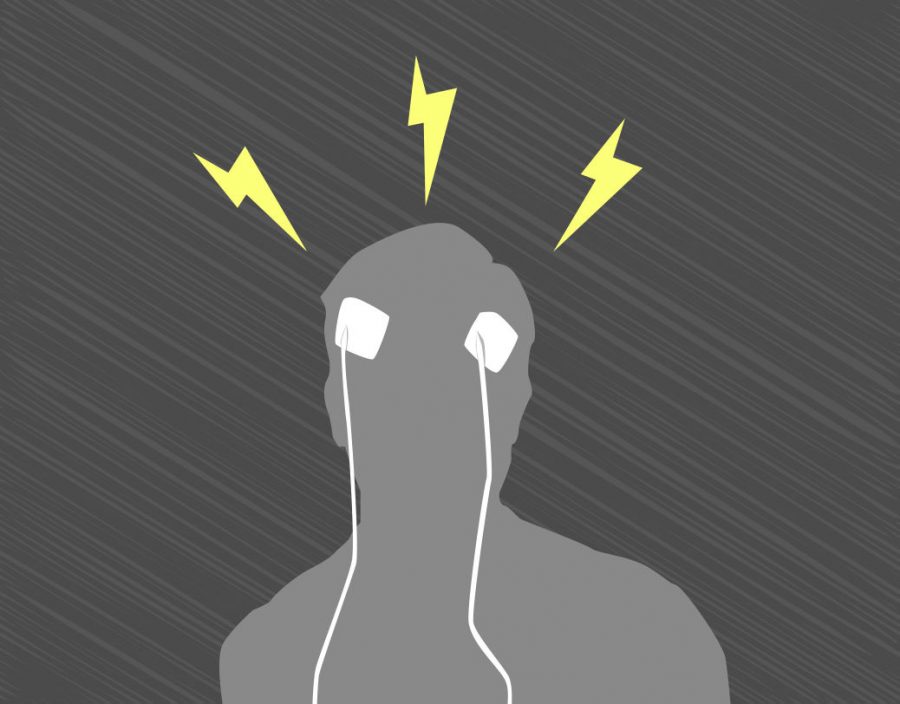DIY devices jolt brain, improve function
tDCS
November 17, 2014
For some, a cup of coffee is the best way to focus on work. But for Vincent Wood, a junior neuroscience major at the University of Pittsburgh, that extra jolt of energy comes from a different source.
Wood uses Transcranial Direct Current Stimulation at home, a device that uses electrodes attached to the head to send a small electrical current to parts of the brain intended to improve its performance.
The device works by applying a weak current to the scalp, which penetrates the brain’s tissue and changes the likelihood of neurons in that region to fire signals or not, thus either enhancing or inhibiting certain processes, according to Jeremy Nelson, science advisor at the Department of Defense Hearing Center of Excellence.
Wood is only one of many who self-administer tDCS outside of a laboratory setting. Use of such brain stimulation has gained momentum among many who practice it at home using DIY devices. There is an entire online community of users who self-administer tDCS and share their experiences through different platforms, including message boards such as reddit and YouTube.
However, tDCS is not approved by the U.S. Food and Drug Administration, and, according to Nelson, research on the technology is still fairly new, so it is difficult to know any long-term risks in using the device.
“[There are] factors that we need to study more thoroughly, so it’s hard to say [what the risks are], and that’s going to be probably everyone’s biggest caution,” Nelson said. “We still don’t know what happens when somebody applies this to themselves for hours or for days, weeks or months.”
Michael T. Weisend, senior research scientist at the Wright State Research Institute, said self-administering tDCS is risky because it can potentially burn the user. Depending on the type of electrodes used, their placement and the voltage level of the device is, users can run the risk of burning their scalps, which could cause scarring.
“The problem with the devices that [some] might make at home is that there’s not the controls we have in a pretty rigorous laboratory setting where there are well-defined parameters,” Nelson said.
If it was possible to create a device that completely controls electrode placement and other parameters that tDCS operates with, users who self-administer tDCS might be able to practice it with less risk.
“On the mechanistic side, we are pretty much in the dark,” Weisend said. “Nobody really knows [the long-term effects], so any time that you want to develop tDCS for [self-application], it’s going to require very careful documentation of what’s going on.”
At first, Wood said he was not worried about the potential negative side effects of the stimulation because he researched tDCS online and found numerous accounts from people who practiced it successfully on their own.
Wood said he uses tDCS while playing improvisational jazz piano and the stimulation helps to increase his overall focus while playing.
“The first time I tried it, I immediately noticed an effect,” Wood said. “You get a light that blinks in the corner of your eyes, [which is] just the exciting of the optical nerves, and I also felt a metallic feeling in the back of my mouth.”
Weisend said he thinks that there will soon be an increase of consumer devices for tDCS, that will increase in popularity until somebody gets hurt from the stimulation, sparking a more careful look at how tDCS works.
“I hope there are a couple of really careful and long-term studies done on how it affects your brain if you use it every day,” Weisend said. “I would also hope that people do a careful job of taking care of [their] skin while passing electricity because [they] can burn themselves.
Weisend also said he worries that users might seek specific results without basing their practices on scientific principles. Results can vary depending on the placement of electrodes, also known as a montage, on a person’s head, so different montages may yield different results.
“For example, if you get up in the morning and you feel like you need your cup of coffee, would you pick a random beverage out of the refrigerator and hope it’s coffee, or would you look specifically [for] the coffee and prepare it in a specific way so that it has a specific effect?” Weisend said. “With tDCS, it’s going to be the exact same way—a specific tool for a specific task in a specific rotation for a specific effect.”








